初一英语全英说课稿
初中英语全英说课稿优秀8篇
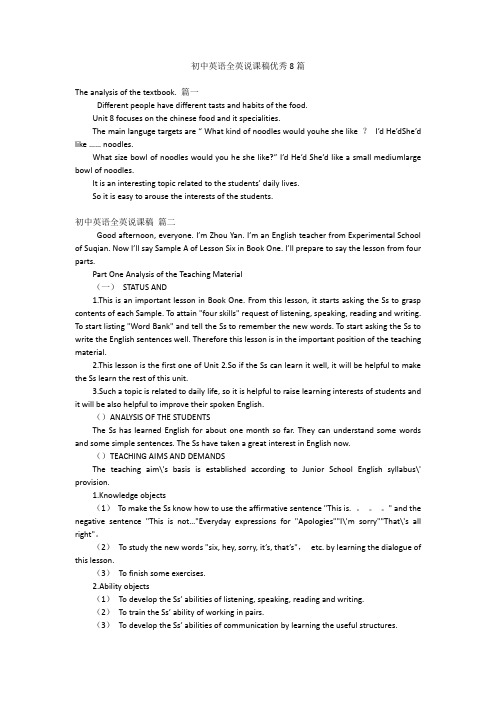
初中英语全英说课稿优秀8篇The analysis of the textbook. 篇一Different people have different tasts and habits of the food.Unit 8 focuses on the chinese food and it specialities.The main languge targets are “ What kind of noodles would youhe she like ?I’d He’dShe’d like …… noodles.What size bowl of noodles would you he she like?” I’d He’d She’d like a small mediumlarge bowl of noodles.It is an interesting topic related to the students’ daily lives.So it is easy to arouse the interests of the students.初中英语全英说课稿篇二Good afternoon, everyone. I’m Zhou Yan. I’m an English teacher from Experimental School of Suqian. Now I’ll say Sample A of Lesson Six in Book One. I’ll prepare to say the lesson from four parts.Part One Analysis of the Teaching Material(一)STATUS AND1.This is an important lesson in Book One. From this lesson, it starts asking the Ss to grasp contents of each Sample. To attain "four skills" request of listening, speaking, reading and writing. To start listing "Word Bank" and tell the Ss to remember the new words. To start asking the Ss to write the English sentences well. Therefore this lesson is in the important position of the teaching material.2.This lesson is the first one of Unit 2.So if the Ss can learn it well, it will be helpful to make the Ss learn the rest of this unit.3.Such a topic is related to daily life, so it is helpful to raise learning interests of students and it will be also helpful to improve their spoken English.()ANALYSIS OF THE STUDENTSThe Ss has learned English for about one month so far. They can understand some words and some simple sentences. The Ss have taken a great interest in English now.()TEACHING AIMS AND DEMANDSThe teaching aim\'s basis is established according to Junior School English syllabus\' provision.1.Knowledge objects(1)To make the Ss know how to use the affirmative sentence "This is. 。
人教版七年级英语上册英语说课稿模板一(全英文)

人教版七年级英语上册英语说课稿模板一(全英文)Good afternoon。
XXX。
My name is () and I am a teacher at () Middle School in ()。
Today。
I will be discussing the topic “What should I do?” and dividing my n into seven parts: Teaching Material Analysis。
Teaching Aims。
Teaching Emphasis。
Teaching Difficulties。
XXX。
Teaching Aids。
and Teaching res.Firstly。
XXX material。
The lesson type for today is a dialogue。
specifically Lesson 33 titled “Saving the Earth”。
This lesson focuses on the topic of the problems facing the earth and the nal items of n。
ns。
Conjecture。
XXX。
it is XXX’ communicative and reading abilities.Moving on。
XXX。
The primary aim of this lesson is to help students understand the XXX express their ns。
ns。
XXX。
XXX skills。
as well as their XXX.Next。
XXX lesson。
we will emphasize the XXX based on the given context.Now。
let's address the teaching difficulties。
初中英语全英说课稿优秀9篇
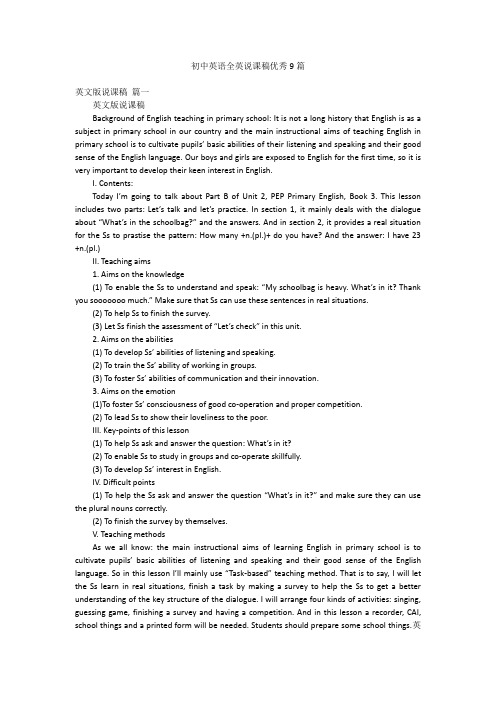
初中英语全英说课稿优秀9篇英文版说课稿篇一英文版说课稿Background of English teaching in primary school: It is not a long history that English is as a subject in primary school in our country and the main instructional aims of teaching English in primary school is to cultivate pupils’ basic abilities of their listening and speaking and their good sense of the English language. Our boys and girls are exposed to English for the first time, so it is very important to develop their keen interest in English.I. Contents:Today I’m going to talk about Part B of Unit 2, PEP Primary English, Book 3. This lesson includes two parts: Let’s talk and let’s practice. In section 1, it mainly deals with the dialogue about “What’s in the schoolbag?” and the answers. And in section 2, it provides a real situation for the Ss to prastise the pattern: How many +n.(pl.)+ do you have? And the answer: I have 23 +n.(pl.)II. Teaching aims1. Aims on the knowledge(1) To enable the Ss to understand and speak: “My schoolbag is heavy. What’s in it? Thank you sooooooo much.” Make sure that Ss can use these sentences in real situations.(2) To help Ss to finish the survey.(3) Let Ss finish the assessment of “Let’s check” in this unit.2. Aims on the abilities(1) To develop Ss’ abilities of listening and speaking.(2) To train the Ss’ ability of working in groups.(3) To foster Ss’ abilities of communication and their innovation.3. Aims on the emotion(1)To foster Ss’ consciousness of good co-operation and proper competition.(2) To lead Ss to show their loveliness to the poor.III. Key-points of this lesson(1) To help Ss ask and answer the question: What’s in it?(2) To enable Ss to study in groups and co-operate skillfully.(3) To develop Ss’ interest in English.IV. Difficult points(1) To help the Ss ask and answer the question “What’s in it?” and make sure they can use the plural nouns correctly.(2) To finish the survey by themselves.V. Teaching methodsAs we all know: the main instructional aims of learning English in primary school is to cultivate pupils’ basic abilities of listening and speaking and their good sense of the English language. So in this lesson I’ll mainly use “Task-based” teaching method. That is to say, I will let the Ss learn in real situations, finish a task by making a survey to help the Ss to get a better understanding of the key structure of the dialogue. I will arrange four kinds of activities: singing, guessing game, finishing a survey and having a competition. And in this lesson a recorder, CAI, school things and a printed form will be needed. Students should prepare some school things.英文版英语说课稿VI. Teaching procedures and purposes of my designing.I’ll finish this lesson in five steps.Step 1. Warm-up and preview1. Free talk between T and Ss about things in the classroom.2. Sing the song together: Books and pencils.3. Do some TPR, for example: Show me your English book. Show me your crayon.4. Review the numbers by asking: “How many crayons do you have?”Purpose: It is important to form a better English learning surrounding for the Ss by singing and doing some total physical response and at the same time it provides situations to review learned knowledge for the next step.Step 2. PresentationNow I’ll mainly talk about this step.1. Present the pattern: “My schoolbag is heavy.” “What’s in it?.”(1) Show a bag and say: “Look! I have a bag.” Carry it and say: “Oh, it is heavy. My schoolbag is heavy.” Help the Ss understand the meaning with the help of my body language. Then lead the Ss to read the sentence. Make sure they can say it correctly.(2) T: My schoolbag is heavy.Open the bag and say: “What’s in it? What’s in my schoolbag?”Take out a Chinese book. Then do the action again. Let the Ss read the sentence.2. Play a guessing game. Divide the whole class into four groups to have a competition.Let them guess: What’s in the bag? How many? Purpose: To present the key structures one by one is much easier for the Ss to learn and grasp the meanings. Proper competition can arouse the Ss’ interest in English learning.3. With the help of the CAI to present the dialogue. Set a situation to help Ss understand: Two Ss are coming. One girl is carrying a heavy bag on her back. They are talking.Girl: My schoolbag is heavy.Boy: What’s in it?Girl: 20 story-books, 32 pencil, 9 rulers, 12 crayons and 30 picture-books. Etc.Boy: What will you do?Girl: They are for the poor.Boy: Great! I’ll bring some school things too.The boy comes back home and puts a lot of things into the bag. Then he goes to school again and gives them to a teacher. While he is taking them out, he is counting the numbers of all things. The teacher says: Thank you soooooooo much.4. Mention that we should take care of the poor.5. Play the cassette. Let the Ss listen and imitate the dialogue.Pay attention to their pronunciation and intonation. Purpose: CAI can provide a real situation for the Ss to understand the dialogue and the relationships between people better. Tell the Ss we should show our loveliness to the Ss.Step 3. PracticeDivide Ss into groups of six children. Each one would finish the printed form by asking and answering: How many storybooks do you have? Find out which group finishes faster. Story books picture-books sharpeners crayons pencils erasers pencil-cases rulers Chen Jie 8 24 3 32 26 4 1 3Purpose: Task-based teaching method is used here to develop Ss’ ability of communication and also their ability of co-operation will be well trained.Step 4. AssessmentHelp Ss finish “Let’s check” of this unit and workbook.Purpose: To check the knowledge Ss have learned in this period.Step 5. Add-activity1. Let Ss tell each other how many school things they have after class. Tell their parents how many school things they have at home.2. Take care of everything they have.Purpose: Revision is so important that Ss should speak English as much as they as in class or after class. It is necessary for the Ss to do some extensive exercises after class to consolidate the knowledge they learned.英文版英语说课稿初中英语说课稿篇二今天我的说课内容是新目标英语八年级上册第四单元第一课时。
初中英语说课稿-全英式经典范例

The Introduction of the teaching planfor section B(1-2c) unit 5 (go for it)I have the honor to reveal my analysis of English lessonhere. I’d like to say I’ll try mybest not to let all of you down. Asteachers ,if youwant to have an excellent class of English ,especially an open class to many experts like all of you, we should have to dig into the teaching material ,analyze the teaching material. However, I thinkweshould take these parts into consideration. ①Teaching material and the students ②teaching methods ③learning methods④procedures ⑤blackboard designand assessment .Ok, let me say something about myteaching plan for unit 5 section B. Today the first I’ll talk about isthe first part “Analysis of the Teaching Material and students”Part One: Analysis of the Teaching Material and students(一) status and functionThe topic of this unit is about decision making. Such topic is related to daily life of students, so it is helpful to raise learning interest of students and it will be helpful to improve their spoken English. This unit is divided into two parts: Section A and Section B. Section B is divided into two periods. This period is the first lesson of Unit5 section B.It introduces new vocabulary while recycling the language presented in Section A. All activities help students integrate the new target language withthe language studied in Section A. This recycling reinforces previous language learning while providing additional practice with newly learned language. It also increases the students listening and speaking ability by listening practice and pair work talking(二) Teaching Aims and DemandsThe teaching aims basis is established according to Jun ior School English syllabus provision. In accordance with the a nalysis of teaching material and the requirements of “go for i t"English teaching syllabuses.The focus of teaching should b e laid on grasping key vocabulary and structures, and developing the students’ability of munication. So I’vedesigned the f ollowing aims and demands1. Knowledge objectsKey vocabulary:agent; make money;travel around the world; get an education Target language:I think you should go to collegeBut if I go to college, I’ll never bee a great soc cer player.2. Ability objects:To train students’ability of listening and speakingTo train students’ability of munication3. Moral objects:Money isn’t everything.To be interested in taking part in activities in English class(三)Teaching key points and difficult points1. Key points:key phrases:travel around the world; make money; get an education key structures:I think you should …。
初一英语说课稿全英
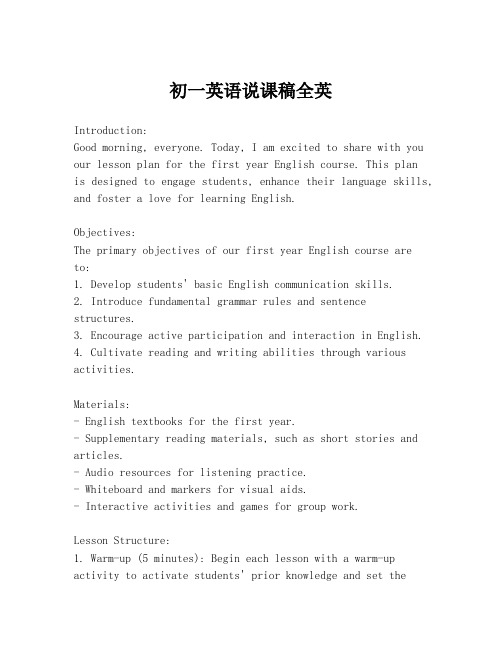
初一英语说课稿全英Introduction:Good morning, everyone. Today, I am excited to share with you our lesson plan for the first year English course. This planis designed to engage students, enhance their language skills, and foster a love for learning English.Objectives:The primary objectives of our first year English course are to:1. Develop students' basic English communication skills.2. Introduce fundamental grammar rules and sentence structures.3. Encourage active participation and interaction in English.4. Cultivate reading and writing abilities through various activities.Materials:- English textbooks for the first year.- Supplementary reading materials, such as short stories and articles.- Audio resources for listening practice.- Whiteboard and markers for visual aids.- Interactive activities and games for group work.Lesson Structure:1. Warm-up (5 minutes): Begin each lesson with a warm-up activity to activate students' prior knowledge and set thestage for the day's topic. This could include a quick vocabulary review or a short conversation starter.2. Presentation (15 minutes): Introduce new vocabulary, grammar points, or reading materials. Use the whiteboard to illustrate concepts and provide examples.3. Practice (20 minutes): Engage students in activities that allow them to practice the new language points. This could include pair work, group discussions, or role-plays.4. Production (15 minutes): Provide opportunities for students to use the language creatively. This could involve writing a short paragraph, creating a dialogue, or giving a presentation.5. Review and Homework (5 minutes): Summarize the key points of the lesson and assign homework that reinforces the day's learning.Assessment:Assessment will be ongoing and will include:- Class participation and engagement in activities.- Performance in quizzes and tests that cover vocabulary, grammar, and reading comprehension.- Completion and quality of homework assignments.Differentiation:Differentiation will be addressed by:- Offering extension activities for advanced students.- Providing additional support and resources for students whoneed extra help.- Encouraging peer-to-peer learning and collaboration.Conclusion:In conclusion, our first year English course aims to provide a solid foundation in English language skills while making learning an enjoyable and interactive experience. We look forward to a successful and enriching academic year with our students.Thank you for your attention, and I am ready to answer any questions you may have about the lesson plan.。
初中英语全英说课稿(优秀5篇)
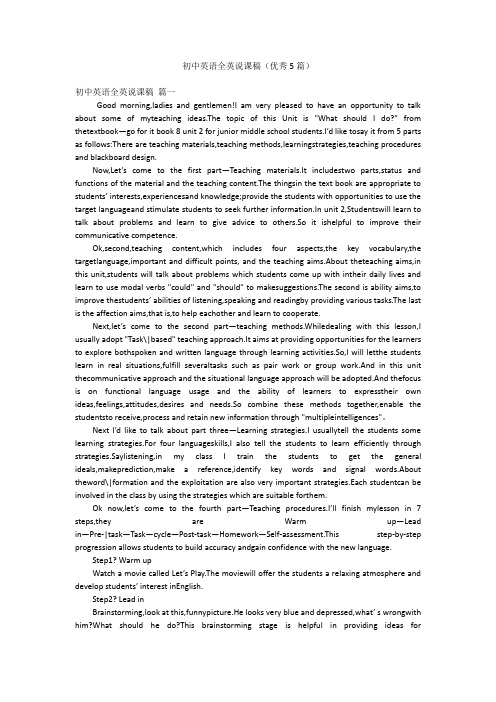
初中英语全英说课稿(优秀5篇)初中英语全英说课稿篇一Good morning,ladies and gentlemen!I am very pleased to have an opportunity to talk about some of myteaching ideas.The topic of this Unit is "What should I do?" from thetextbook—go for it book 8 unit 2 for junior middle school students.I’d like tosay it from 5 parts as follows:There are teaching materials,teaching methods,learningstrategies,teaching procedures and blackboard design.Now,Let’s come to the first part—Teaching materials.It includestwo parts,status and functions of the material and the teaching content.The thingsin the text book are appropriate to students’ interests,experiencesand knowledge;provide the students with opportunities to use the target languageand stimulate students to seek further information.In unit 2,Studentswill learn to talk about problems and learn to give advice to others.So it ishelpful to improve their communicative competence.Ok,second,teaching content,which includes four aspects,the key vocabulary,the targetlanguage,important and difficult points, and the teaching aims.About theteaching aims,in this unit,students will talk about problems which students come up with intheir daily lives and learn to use modal verbs "could" and "should" to makesuggestions.The second is ability aims,to improve thestudents’ abilities of listening,speaking and readingby providing various tasks.The last is the affection aims,that is,to help eachother and learn to cooperate.Next,let’s come to the second part—teaching methods.Whiledealing with this lesson,I usually adopt "Task\|based" teaching approach.It aims at providing opportunities for the learners to explore bothspoken and written language through learning activities.So,I will letthe students learn in real situations,fulfill severaltasks such as pair work or group work.And in this unit thecommunicative approach and the situational language approach will be adopted.And thefocus is on functional language usage and the ability of learners to expresstheir own ideas,feelings,attitudes,desires and needs.So combine these methods together,enable the studentsto receive,process and retain new information through "multipleintelligences"。
人教版七年级英语上册英语说课稿一(全英文)

人教版七年级英语上册英语说课稿一(全英文)第一篇:人教版七年级英语上册英语说课稿一(全英文)英语说课稿模板一(全英文)Good afternoon, ladies and gentlemen.My name is().I come from()Middle School in().T oday I’m going to talk about the topic” What should I do?”I will divide the instruction into seven parts:they are Teaching material Analysis, Teaching aims, Teaching emphasis, Teaching difficulties, Teaching methods, Teaching aids and Teaching procedures.一、说教材(教材分析)Analyzing teaching material 1.说课型lesson type(Dialogue/ reading/ listening/ revision)2.本课在教材中的地位status and function Lesson 33 Saving the Earth is a dialogue.The lesson is focused on the topic of the problems of the earth and the functional items of Supposition/ Intentions/ conjecture/ Prohibition.Since it is a dialogue / reading.It’s helpful to improve the Ss communicative/ reading ability.3.说教学指导思想teaching guideline(Teaching syllabus: Language is for communication, develop their four skills, lay special emphasis on reading;Grellet put it well in his book developing reading skills: develop reading skill/ discourse analysis;get them to understand the western culture better;improve the ability to discover, analyze & solve the problems;Reading is for information, for fun;Use T op-down model or Bottom-up model to activate Ss schemata;Interactive model)4.说教学目标和要求Teaching aims and demands(…be intended for Ss in key schools)1)认知目标knowledge objects a.Enable the Ss to remember the following new words & phrases: Damage, lecture, pollute, pollution, room, standing room, be fit for, hear about, turn into b.Get the Ss to be familiar with this sentence pattern: If the population keeps growing so quickly,there will only be standing room left… Give the Ss a reinforced practice on the functional item Supposition.c.Activate Ss schemata regarding the topic of pollution and help Ss to know more about the problem of pollution.2)智能目标 ability objects a.Ask the Ss to make up a similar dialogue.b.Help them to understand the dialogue better and improve the four skills.c.Develop their ability of thinking independently.d.Cultivate their ability to discover, analyze and solve problems.e.Train them to collect information from the Internet.f.Train them with some effective learning methods to optimize Ss’ learning res ults.3)德育目标moral objects a.Arouse their interest in learning English;b.Help them to understand the background of pollution.c.Enable the students to love our earth and the nature.d.Be aware of the importance of stopping pollution & protecting out environment.e.Encourage the Ss to do something to save the earth.5.说教学重点 teaching important points(生词、句型;培养阅读技能)a.New words and phrases b.Sentence pattern: If-clause c.improve their reading skills.d.Talking about problems of the Earth.6.说教学难点 teaching difficult points(语法;发展交际能力)a.functional item: Supposition.b.Develop their communicative ability.Act out their own dialogue.7.说教具teaching aids(multi-media computer, software, OHP)The teaching syllabus says that it’s necessary for teachers to use modern teaching facilit ies.It’s of great help to increase the class density and improve our teaching result.It can also make the Ss reach a better understanding of the text by making the classes lively and interesting.At the same time, it arouses the Ss’ interest in learning English.二、说教法T eaching methods Five step method;audio-video;communicative approach;Task-based learning: New Syllabus Design encourages teachers to use thisteaching method.TBLT can stimulate Ss’ initiative in learning and develop their ability in language application.Make the Ss the real masters in class while the teacher himself acts as the director and bring their ability into full play.三、说学法Study methods 1.Teach Ss how to be successful language learners.2.Teach Ss how to develop the reading skill — skim & scan;how to communicate with others;how to learn new words;how to learn independently;3.Get the Ss to form good learning habits.四、说教学过程Teaching procedures I.复习(Revision)5min(Daily report;词汇diagram;brainstorming;activate schemata)Activity 1: Imagination 1).Suppose a bottle of ink is turned over and dirties your white shirt, what is to be done?(Wash it? Or throw it away?)2).Suppose you catch a bad cold, what’s to be done?3).Suppose your bike is broken, what’s to be done?4).And suppose the earth, on which we all live, is damaged, what’s to be done? * What can you think of when you see “pollution” this word?(waste, environment, air, water, factory, desert, climate...Try to activate the Ss schemata regarding the topic of pollution.)II.呈现(Presentation)5min Activity 2: Presentation Play the song “Earth Song” sung by Michael Jackson.(Create an atmosphere)A lot of pictures and video clips about the causes and results of the three problems mentioned in this lesson will be shown on the screen with the help of the comp uter.Ss’ presentation on pollution.Attract their attention, arouse their interest, and create a good atmosphere for communication.* Activate their schemata and cultivate their ability in collecting information from the Internet and develop their ability in thinking independently.III.对话/ 阅读(Dialogue)18m 1.Pre-reading Activity 3: Prediction 1st listening/ fast reading, one guided Q to help Ss to get the main idea: Whatdo you think is discussed at the conference? 2.While-reading Activity 4: Read and answer 2nd listening/ careful reading, more Qs to get the detailed information.Develop their reading skills: skim & scan.Pay attention to the pronunciation, stress & intonation.* 阅读: Pre-reading;while-reading;post-reading(fast reading/ careful reading;skim/ scan;识别关键词key words;确定主题句;创设信息差information gap;T or F;填表格chart/diagram;Predicting;Make a timeline;Make a story map。
人教版初中英语说课稿7篇
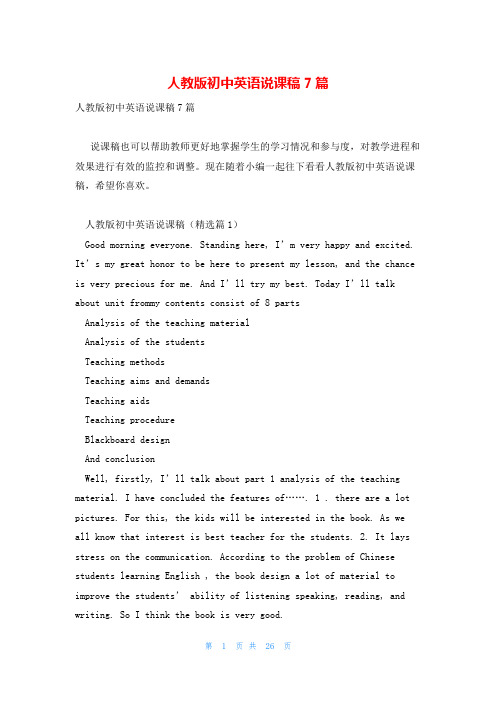
人教版初中英语说课稿7篇人教版初中英语说课稿7篇说课稿也可以帮助教师更好地掌握学生的学习情况和参与度,对教学进程和效果进行有效的监控和调整。
现在随着小编一起往下看看人教版初中英语说课稿,希望你喜欢。
人教版初中英语说课稿(精选篇1)Good morning everyone. Standing here, I’m very happy and excited. It’s my great honor to be here to present my lesson, and the chance is very precious for me. And I’ll try my best. Today I’ll talk about unit frommy contents consist of 8 partsAnalysis of the teaching materialAnalysis of the studentsTeaching methodsTeaching aims and demandsTeaching aidsTeaching procedureBlackboard designAnd conclusionWell, firstly, I’ll talk about part 1 analysis of the teaching material. I have concluded the features of……. 1 . there are a lot pictures. For this, the kids will be interested in the book. As we all know that interest is best teacher for the students. 2. It lays stress on the communication. According to the problem of Chinese students learning English , the book design a lot of material to improve the students’ ability of listening speaking, reading, and writing. So I think the book is very good.Then I’ll talk about next part analysis of the students. It is known to us that the kids are very active and like playing games very much, so during my class, I’ll design some interesting games to activate them to participate and learn something. They will also be interested in the class.Next I’ll talk about teaching methods. My teaching methods are task-based approach and situational approach. Using different methods can make the class active.Let’s move on to another part, teaching aims and demands. There are knowledge aims and ability aim.Knowledge aims are to enable the students to master the words and phrases:………. And the sentences:…Ability aims are To improve students’listening and speaking ability by reading and practicing the dialogue.Next is the teaching aids. In this class, I’ll use pictures, PPT and t ape recorder. These can arouse the students’ interest in English.Now I’ll talk about most important part teaching procedure. It consists of 5 steps. Warning up, lead-in, contents key points and difficult points and homework.Step1 is warming up. Her e I’ll use PPT to play a English song Bingo for the students and I’ll ask them try to follow it to sing together. By this, the students can be interested in it and pay their attention to our class easily and improve their ability of speaking. Step2 is lead-in (导入根据所授内容设计,可通过展示与本课有关的话题或者图片等等引出本课话题)Step 3 is contents(本部分为主要授课内容及组织的课堂活动。
- 1、下载文档前请自行甄别文档内容的完整性,平台不提供额外的编辑、内容补充、找答案等附加服务。
- 2、"仅部分预览"的文档,不可在线预览部分如存在完整性等问题,可反馈申请退款(可完整预览的文档不适用该条件!)。
- 3、如文档侵犯您的权益,请联系客服反馈,我们会尽快为您处理(人工客服工作时间:9:00-18:30)。
初一英语全英文说课稿Good afternoon, everyone. I’m Zhou Yan. I’m an English teacher from Experimental School of Suqian. Now I’ll say Sample A of Lesson Six in Book One. I’ll prepare to say the lesson from four parts.Part One Analysis of the Teaching Material(一) STATUS AND FUNCTION1.This is an important lesson in Book One. From this lesson, it starts asking the Ss to grasp contents of each Sample. To attain “four skills” request of listening, speaking, reading and writing. To start listing “Word Bank” and tel l the Ss to remember the new words. To start asking the Ss to write the English sentences well. Therefore this lesson is in the important position of the teaching material.2.This lesson is the first one of Unit 2.So if the Ss can learn it well, it will be helpful to make the Ss learn the rest of this unit.3.Such a topic is related to daily life, so it is helpful to raise learning interests of students and it will be also helpful to improve their spoken English.(二)ANALYSIS OF THE STUDENTSThe Ss has learned English for about one month so far. They can understand some words and some simple sentences. The Ss have taken a great interest in English now.(三)TEACHING AIMS AND DEMANDSThe teaching aim\'s basis is established according to Junior School English syllabus\' provision.1.Knowledge objects(1) To make the Ss know how to use the affirmative sentence “This is. . . .” and the negative sentence “This is not….”Everyday expressions for “Apologies”“I\'m sorry”“Th at\'s all right”.(2) To study the new words “six, hey, sorry, it’s, that’s”, etc. by learning the dialogue of this lesson.(3) To finish some exercises.2.Ability objects(1) To develop the Ss’ abilities of listening, speaking, reading and writing.(2) To train the Ss’ ability of working in pairs.(3) To develop the Ss’ abilities of communication by learning the useful structures.3.Moral objects(1) To enable the Ss to be polite and love life.(2) To enable the Ss to look after their things well.(四)TEACHING KEY AND DIFFICULT POINTSThe teaching key and difficult points’ basis is established according to Sample A of Lesson Six in the teaching material\'s position and function.1.Key points:(1).To help the Ss to communicate with each other.(2).To enable the Ss to study in groups and co-operate skillfully.(3).To develop the Ss’ interest in English.2.Difficult points:(1) How to make dialogues and act them out.(2) How to write the right whole sentences.(五) TEACHING AIDSMulti-media computer, Tape recorder, Software: Powerpoint or Authorware, school things and so on. They will be needed in this lesson.Part Two The Teaching Methods1. Communicative teaching method2. Audio-visual teaching method3. Task-based” teaching methodAs we all know: the main instructional aims of learning English in the Middle School is to cultivate students’ abilities of listening, speaking, reading, writing and their good sense of the English language. So in this lesson I’ll mainly use “Communicative” teachi ng method, “Audio-visual” teaching method and “Task-based” teaching method. That is to say, I’ll let the Ss to get a better understanding of the key structure of the dialogue. I’ll give the Ss some tasks and arrange five kinds of activities: talking, guessing games, watching CAI, acting out Sample A and having a competition.Teaching special featuresTo use these methods are helpful to develop the Ss’ thought.Part Three STUDYING WAYS1.Teach the Ss how to be successful language learners.2.Let the Ss pass \"Observation—Imitation—Practice \" to study language.3.Teach the Ss how to master dialogues and how to communicate with others. Teaching special features:Let the Ss communicate with each other and adopt competition methods to develop the Ss’ kee n interest in English.Part Four Teaching ProcedureI’ll finish this lesson in four steps. First I’ll divide the Ss into four groups and bring a competition into the class. At last let’s see which group is the winner.Step1 Warm-up1. Free talk between T and Ss .Such as: Hi, I’m . . . . What’s your name?This is …. How do you do?Who is he/she? How are you?Who can count from 1to 5?What’s this in English? etc.2.A game: Ask the Ss to give T some school things. For example:T: Give me your book.(ruler, box, pen, table, knife, etc.)T: This is your book. This is not my book. It’s your book. etc.In this course I’ll ask them to make a dialogue group by group without repetition. Find out which group will make the most dialogues.Purpose of my designing: I think it is important to form a better English learning surrounding for the Ss by imitating and at the same time it is necessary to provide situations to review learned knowledge.Step2. PresentationThis course is very important. I’ll mainly t alk about this step.I’ll use CAI to present the whole dialogue. Arrange some situations to help Ss understand Sample A.First scene: There is a bag on the floor. B is picking it up and get ready to leave. Now A is talking with B.A: Hi, B. How are you today?B: I’m fine, thank you. And you?A: I’m fine, too. Oh, this is my bag.B: No, this is not your bag. It’s my bag.A: (Look closely) Oh, I’m sorry.B: That’s all right.(At the same time, C is running up and hitting A.)C: Oh, I’m sorry.A: Th at’s OK.I’ll write the key points on the Bb while they are watching. After watching, I’ll teach them to read the words and sentences on the Bb. Make sure they can read them well.Purpose of my designing: To present Sample A by CAI is much easier for the Ss to learn and grasp the meanings. CAI can provide a real situation with its sound and picture and it makes the relationships between the Ss better.Step3.PracticeFirst play the tape recorder. Let the Ss listen and imitate the dialogue. Pay attention to their pronunciation and intonation. In this step the Ss are required to practise the Sample in pairs by reading the dialogue aloud. This step is employed to make the Ss grasp the Sample .At last I’ll ask the Ss to think hard and act it out with a partne r according to Sample A. Then find out which group will act it out well. I’ll give them red stars.Purpose of my designing: This step is employed to make the Ss get the general idea of the dialogue as a whole one. At the same time let the Ss have a chance to practise their listening and spoken ability.Step4.ProductionIn this step I’ll give the Ss a free space to show their abilities.Second scene: The Ss are having a picnic. It’s hot and they take off their coats and put them together. They are singing and dancing, laughing and chatting. After the picnic, they begin to look for their coats. D and E are talking. F and G are talking. etc.After watching, I’ll give the Ss some tasks to make similar dialogues without repetition and find out which group will make more dialogues.Purpose of my designing: “Task-based” teaching method is used here to develop the Ss’ ability of communication and also their ability of co-operation will be well trained. Tell the Ss we should be polite and take good care of our things. We should love our life. I think proper competition can arouse the Ss’ interest in English learning. If the Ss can finish this task well, they will benefit a lot in their spoken English.2.Skill 1 Model 1.I’ll ask four Ss of the groups to write these sentences on the Bb in the four lines.Then check their handwriting, correct their mistakes. Find out who will write well and whose handing is the best.3.Finish the Ss’ workbook.Purpose of my designing: To check the knowledge Ss have learned in this lesson.Step5.Homework:(1)Recite the words as many as possible after class.(2)Make a dialogue according to Sample A and write it in the exercise book.Purpose of my designing: I think homework is so important that the Ss should speak English as much as they can in class or after class. It is necessary for the Ss to do some extensive exercises after class to consolidate the knowledge they learned.Blackboard DesignLesson Six Sample ASix This is my….hey This is not your. . . .sorry It’s my. . . . Picture it’s=it is Oh, I’m sorry.that’s=that is That’s all right/OK.。
